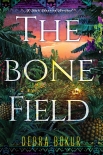The Bone Field, Debra Bokur [book club reads .TXT] 📗

- Author: Debra Bokur
Book online «The Bone Field, Debra Bokur [book club reads .TXT] 📗». Author Debra Bokur
He gathered the remaining loose photos into a small stack and handed them to her. She looked closely at each one. The faces were Portuguese, Asian, Hawaiian, Black, Hispanic, Filipino, and White, men and women and a good number of older teens.
In one, a row of baskets sat on the ground, filled with what looked like green, sharp pineapple leaves.
“The fruit grows from the crowns,” he told her. He sighed, as though remembering. “All planted by hand—long row after row of crowns shoved into the earth.”
He leaned forward, reaching for the book and selecting another image showing a woman standing alone. He sat holding it for a moment, gazing at the woman’s face, then handed the photo to Kali. The woman was wearing a hat to protect her face and head from the sun, but her shy smile was clearly visible. She was wearing what appeared to be a pair of thick gloves, and one hand was holding a large pineapple by its green, spiky crown.
“This is my late wife, Carolina. Made the best coconut cake in the world. She worked on the picking line, laying fruit on the conveyer belt. The fruit would end up in a truck bed, then be sorted and packed with the crown facing down to be transported to the dock for the barge trip to the processing plant off-island. The best-looking ones were left whole, to be sold at the markets.” His face darkened. “After they were sprayed again, of course.”
Kali was silent, waiting for whatever it was that he wanted or needed to say.
“No one wants to talk about it,” he said. He looked through the photos on the table, choosing another one. There were two men in the image, standing on the back of a large truck. “These guys both died a few years after the plants closed. Cancer. I think it was from the chemical sprays. My wife, too. She was only fifty-two.”
All Kali could hear was the whirring of a small table fan set in front of an open window, blowing into the house from the lanai. Then she heard a car passing on the road in front of the house, a snippet of music from its radio momentarily lilting across the air, linking the listener in the car to herself. Once again, she sat, absorbing yet another story of loss told to her by a still-grieving stranger.
“I’m sorry,” she said. “I’ve heard about the heavy spraying. Pesticides?”
“Fungicides, too. To kill nematodes. Mealybugs and the like. They sprayed those plants regularly, and the rest of us couldn’t help but breathe it in or get it on us. They kept telling us it was safe. I got lucky, somehow. I don’t know why.” He looked at her. “There was even an extra spray treatment at the end of the harvesting for the whole fruits heading to supermarkets. As if no one ever made the connection that chemicals that killed one kind of life would of course have an effect on all the other life nearby. Those executives. Greedy, all of them. Gambling with other peoples’ lives.”
“The pineapple company people?”
He nodded. “Them and the chemical company people, working together. The bigwigs in their sharp suits, stopping by for a few days in the islands to get a tan and mingle with the natives.” He lifted the heavy album and searched through it, peering closely at the images. Finally, he passed the album to Kali and pointed to a picture at the bottom of one page.
“Those guys are the ones we mostly dealt with. That picture was taken at a little awards dinner they held after some important harvesting record got broken.”
In the image, three men stood together in a group in front of a banquet table. They all looked happy. The man in the middle held a plaque, and each of the men standing beside him was turned slightly toward it, each resting a hand on the shoulder of the center man.
Kali took it in, then turned the page, gazing at scenes from past growing seasons, and the faces and figures of strangers. Her eyes froze suddenly on a photo showing several ladies in the act of preparing food at a counter. To their left was a yellowish-brown refrigerator that looked very familiar. She slipped the photo from its sleeve and handed it to Manuel.
“Where was this taken?” she asked.
He held the photo up, studying it. “That was our new break room. Those ladies were some of the planters.”
“Can you tell me anything about the refrigerator?”
He looked at her as though she’d just asked him to reupholster her flying saucer, then gazed back at the photo.
“The refrigerator?”
“Yes. Was it new? Do you remember what year this was taken? Do you know what happened to the fridge?”
He sat back, still looking at her in confusion. “Well . . . let me see. It was a big deal when we got it, because the old one leftover from the previous pineapple company had been on the blink and we needed something to keep lunch things in. We were given three used ones, and this was the nicest one. We only got it just a couple of years before those of us who were still working all lost our jobs. So, summer of 1994 or ’95 would be my guess.”
“There were others? Were they the same as this one—brand and color, for instance?”
“No, the other two were small, old, beat-up ones that had been donated at various times. I think they were both white. This big fancy golden one was a gift from the management people. They could have afforded to give us a new one, but we





Comments (0)